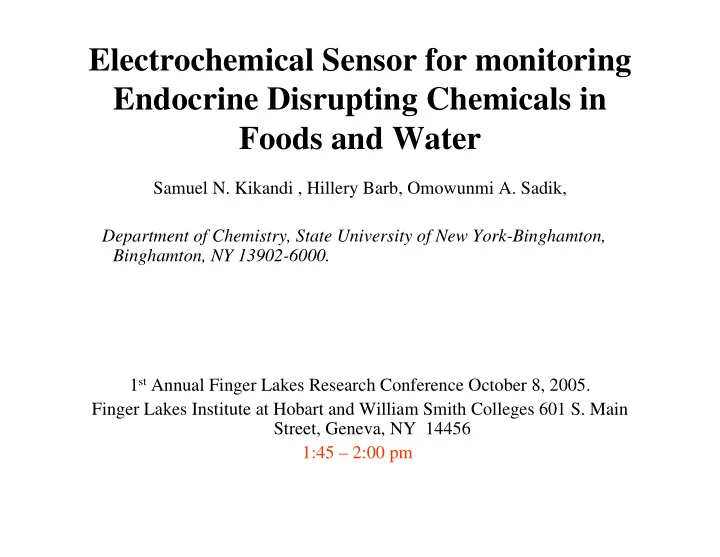

Electrochemical Sensor for monitoring Endocrine Disrupting Chemicals in Foods and Water Samuel N. Kikandi , Hillery Barb, Omowunmi A. Sadik, Department of Chemistry, State University of New York-Binghamton, Binghamton, NY 13902-6000. 1 st Annual Finger Lakes Research Conference October 8, 2005. Finger Lakes Institute at Hobart and William Smith Colleges 601 S. Main Street, Geneva, NY 14456 1:45 – 2:00 pm
Outline • Background information • EDCs screening methods/techniques • Objective • Our technical approach • Preliminary results • Conclusion • On-going /future work • Acknowledgement
Backgound information • Endocrine disrupting chemicals(EDCs) are chemicals commonly called environmental hormones that mimic or block the natural estrogen activities in the body by binding to the estrogen receptor • There is increasing concern worldwide over the adverse effects of endocrine disrupting chemicals (EDCs) on human health . • Has created a need for screening systems to detect the diverse group of environmental chemicals that mimic estrogenic actions and are hypothesized to decrease male fertility
Compound Commercial products -Synergistic combination of quercetin and vitamin C -Promotes healthy immune and respiratory system function Figure 1:Quercetin and commercial products
Compound Commercial product -Powerful antioxidant for anti-aging benefits Resveratrol. -Promotes a healthy lipid balance -Supports the immune and cardiovascular systems Figure 2:Resveratrol and commercial products
Compound Commercial product Genistein, an isoflavone phytonutrient derived from soybeans, has been the focus of Genistein(GEN) scientific research since 1966 Other available category: Menopause and prostrate Figure 3 : Genistein and commercial products
Screening Analytical methods/Techniques(1) • Screening systems to detect environmental estrogen reported in our lab( Sadik O. A., Witt D . Environmental Science & Technology – Feature Article , 33(17): A368-75, 1999) • Fluorescence immunoassays , which are capable of detecting endocrine disrupting compounds in wastewater have been reported( Yan F., Sadik O. A. Analytical Chemistry , 2001 , 73, 5272-5280) • LC/MS to supplant GC/MS methods that require derivatizations has also been reported [ Pure Appl. Chem., Vol. 75, Nos. 11–12, pp. 1843–1857, 2003]
Screening Analytical methods/Techniques(2) • Electrochemical detection mechanism has been proposed in our lab [Ngundi M. Sadik O.A., Suye S., Takashi Y . Electrochemistry communications 5 (1): 61-67 Jan 2003] • Amperometric tyrosinase-based biosensor (Tyr- CPE) reported for the detection of some EDCs in our lab [Silvanna A and Sadik O.A Anal. Chem. 2004, 76, 552-560] However, real time stepwise electrochemical mechanisms or mode of action are unknown !
Objectives • To determine the real time mode of action action/ mechanism •Develop a real time electrochemical sensor for both quantitative and qualitative analysis of EDCs real samples(water, foods,fruits and so on)
Technical approach Specifically: • Improve EDCs to a better detection limit than currently reported to facilitate Electrochemical and GC-MS determination • Follow up electrochemical processes for real samples at real time. • Design electrochemical sensor that is less complex, more robust and has good sensitivity, reliability, reproducibility and low detection limit.
Preliminary results on Quercetin Table : Theoretically Predicted free and derivatized quercetin m/z values with derivatization Experiment progression Retention, 14.98 15.21 26.56 27.16 Rt,min. nTMS +2TMS +3TMS 4TMS 5TMS (predicted) -6CH 3 -6CH 3 -CH 3 -CH 3 m/z Predicted 356 429 575 647 Observed 355,357 428 575 647
Results: GC-MS (1) 3500000 quercetin 27.14 3000000 BPA Quercetin 2500000 14.9 (polar) A bundance 2000000 1500000 Si 19.1 O 1000000 O Si Si 500000 O O 0 Si 0 10 20 30 40 O Time(min) O O Derivatized Si Quercetin Figure 4: Total ionic chromatogram(TIC) (less polar) of derivatized quercetin
Results : GC-MS (2) +3TMS 25000 450000 73 -6CH 3 +2TMS 357 400000 -6CH 3 20000 350000 355 300000 429 15000 A bunda nc e Abundance 250000 10000 200000 503 150000 5000 100000 372 73 207 50000 0 0 0 200 400 600 800 0 200 400 600 800 -5000 m/z M/z Figure5 : Quercetin m/z values observed for (a) addition of 2 TMS (b) addition of 3 TMS
Results: GC-MS (3) 80000 800000 647 575 At R t =26.55 At R t =27.16 70000 700000 min +5TMS 60000 600000 +4 TMS -1CH 3 -1 CH 3 50000 abundance Abundance 500000 40000 400000 30000 300000 73 575 20000 200000 73 207 487 10000 100000 0 0 0 200 400 600 800 0 200 400 600 800 m/z m/z Figure 5: Derivatized quercetin m/z values observed for(c) addition of 4 TMS (d) addition of 5 TMS
Results(4): Electrochemistry Bulk electrolysis Stepwise oxidation of quercetin 0.5 hr -12 1 hr -10 2 hr -8 Current(µA) -6 -4 16.5 hr -2 0 2 250 450 650 850 1050 Potential(E vs Ag /Ag+ 0.1M) V Figure 6 :Cyclic voltammetry of quercetin in organic solvent • Electrochemical data supports the GC-MS results • Suggests a stepwise oxidation mechanism for quercetin
Results (5) :UV-VIS tb 0.9 t0( 0hrs) 0.8 t2(1.08 hr) t3(1.67 hr) 0.7 t4(2.08 hr) Wavelength(nm)=432 nm 0.6 t5(2.5 hr ) t6(3 hr) 0.5 t7(3.5 hr) 0.4 t8(17 hrs) 0.3 0.2 0.1 0 190 290 390 490 590 -0.1 -0.2 Figure 7: Results showing the changes in the UV/VIS spectra of Quercetin
Summary/Conclusions •GC-MS:Stepwise derivatization of quercetin –OH groups has been observed •Electrochemistry:Quercetin oxidation appears to follow a step by step electrochemical mechanism •UV-VIS:New compound(s)/intermediate forms •GC-MS, electrochemistry and UV-VIS data agree. •Electrochemical sensor development is feasible for Quercetin and other EDCs •We can determine the real time levels and nature of EDCs in water, drinks, foods and fruits which is a good indicator of the level of quality for health and environment purposes
On-going and Future work •Follow up the quercetin real time electrochemical oxidations coupled with improved GC-MS detection limit of detection. • Determine using real time levels and nature of EDCs in water, foods, drinks and fruits Acknowledgement • This work was supported by the National Science Foundation and the NYS Center for Advanced Technology.
Recommend
More recommend